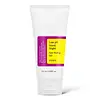What's inside
What's inside
 Key Ingredients
Key Ingredients

 Benefits
Benefits

 Concerns
Concerns

 Ingredients Side-by-side
Ingredients Side-by-side

Water
Skin ConditioningBambusa Arundinacea Stem Powder
AbrasiveCellulose
AbsorbentGlycerin
HumectantRosa Damascena Flower Water
MaskingPropanediol
SolventButylene Glycol
Humectant1,2-Hexanediol
Skin ConditioningAcrylates/C10-30 Alkyl Acrylate Crosspolymer
Emulsion StabilisingHydroxyacetophenone
AntioxidantLavandula Angustifolia Flower Water
Skin ConditioningTromethamine
BufferingNiacinamide
SmoothingMaltodextrin
AbsorbentEthylhexylglycerin
Skin ConditioningDisodium EDTA
Pentylene Glycol
Skin ConditioningLactobionic Acid
BufferingPapain
Skin ConditioningHyaluronic Acid
HumectantHydrolyzed Hyaluronic Acid
HumectantLactobacillus/Soybean Ferment Extract
Skin ConditioningSodium Hyaluronate
HumectantSodium Metabisulfite
AntioxidantLactobacillus/Rice Ferment
Skin ConditioningCamellia Japonica Flower Extract
EmollientWater, Bambusa Arundinacea Stem Powder, Cellulose, Glycerin, Rosa Damascena Flower Water, Propanediol, Butylene Glycol, 1,2-Hexanediol, Acrylates/C10-30 Alkyl Acrylate Crosspolymer, Hydroxyacetophenone, Lavandula Angustifolia Flower Water, Tromethamine, Niacinamide, Maltodextrin, Ethylhexylglycerin, Disodium EDTA, Pentylene Glycol, Lactobionic Acid, Papain, Hyaluronic Acid, Hydrolyzed Hyaluronic Acid, Lactobacillus/Soybean Ferment Extract, Sodium Hyaluronate, Sodium Metabisulfite, Lactobacillus/Rice Ferment, Camellia Japonica Flower Extract
Water
Skin ConditioningGlycerin
HumectantDipropylene Glycol
HumectantCoco-Betaine
CleansingTea-Cocoyl Glutamate
CleansingPotassium Lauroyl Glutamate
CleansingButylene Glycol
HumectantCitric Acid
BufferingSodium Citrate
BufferingNiacinamide
SmoothingHydrolyzed Silk
HumectantPhenoxyethanol
PreservativeLonicera Japonica Flower Extract
Skin ConditioningPerilla Ocymoides Leaf Extract
TonicCitrus Unshiu Peel Extract
MaskingAngelica Keiskei Leaf/Stem Extract
Skin ConditioningGlycyrrhiza Glabra Leaf Extract
Skin ConditioningPrunus Persica Kernel Extract
MoisturisingCoix Lacryma-Jobi Ma-Yuen Seed Extract
Skin ConditioningWater, Glycerin, Dipropylene Glycol, Coco-Betaine, Tea-Cocoyl Glutamate, Potassium Lauroyl Glutamate, Butylene Glycol, Citric Acid, Sodium Citrate, Niacinamide, Hydrolyzed Silk, Phenoxyethanol, Lonicera Japonica Flower Extract, Perilla Ocymoides Leaf Extract, Citrus Unshiu Peel Extract, Angelica Keiskei Leaf/Stem Extract, Glycyrrhiza Glabra Leaf Extract, Prunus Persica Kernel Extract, Coix Lacryma-Jobi Ma-Yuen Seed Extract
 Reviews
Reviews

Ingredients Explained
These ingredients are found in both products.
Ingredients higher up in an ingredient list are typically present in a larger amount.
Butylene Glycol (or BG) is used within cosmetic products for a few different reasons:
Overall, Butylene Glycol is a safe and well-rounded ingredient that works well with other ingredients.
Though this ingredient works well with most skin types, some people with sensitive skin may experience a reaction such as allergic rashes, closed comedones, or itchiness.
Learn more about Butylene GlycolGlycerin is already naturally found in your skin. It helps moisturize and protect your skin.
A study from 2016 found glycerin to be more effective as a humectant than AHAs and hyaluronic acid.
As a humectant, it helps the skin stay hydrated by pulling moisture to your skin. The low molecular weight of glycerin allows it to pull moisture into the deeper layers of your skin.
Hydrated skin improves your skin barrier; Your skin barrier helps protect against irritants and bacteria.
Glycerin has also been found to have antimicrobial and antiviral properties. Due to these properties, glycerin is often used in wound and burn treatments.
In cosmetics, glycerin is usually derived from plants such as soybean or palm. However, it can also be sourced from animals, such as tallow or animal fat.
This ingredient is organic, colorless, odorless, and non-toxic.
Glycerin is the name for this ingredient in American English. British English uses Glycerol/Glycerine.
Learn more about GlycerinNiacinamide is a multitasking form of vitamin B3 that strengthens the skin barrier, reduces pores and dark spots, regulates oil, and improves signs of aging.
And the best part? It's gentle and well-tolerated by most skin types, including sensitive and reactive skin.
You might have heard of "niacin flush", or the reddening of skin that causes itchiness. Niacinamide has not been found to cause this.
In very rare cases, some individuals may not be able to tolerate niacinamide at all or experience an allergic reaction to it.
If you are experiencing flaking, irritation, and dryness with this ingredient, be sure to double check all your products as this ingredient can be found in all categories of skincare.
When incorporating niacinamide into your routine, look out for concentration amounts. Typically, 5% niacinamide provides benefits such as fading dark spots. However, if you have sensitive skin, it is better to begin with a smaller concentration.
When you apply niacinamide to your skin, your body converts it into nicotinamide adenine dinucleotide (NAD). NAD is an essential coenzyme that is already found in your cells as "fuel" and powers countless biological processes.
In your skin, NAD helps repair cell damage, produce new healthy cells, support collagen production, strengthen the skin barrier, and fight environmental stressors (like UV and pollution).
Our natural NAD levels start to decline with age, leading to slower skin repair, visible aging, and a weaker skin barrier. By providing your skin niacinamide, you're recharging your skin's NAD levels. This leads to stronger, healthier, and younger looking skin.
Another name for vitamin B3 is nicotinamide. This vitamin is water-soluble and our bodies don't store it. We obtain Vitamin B3 from either food or skincare. Meat, fish, wheat, yeast, and leafy greens contain vitamin B3.
The type of niacinamide used in skincare is synthetically created.
Learn more about NiacinamideWater. It's the most common cosmetic ingredient of all. You'll usually see it at the top of ingredient lists, meaning that it makes up the largest part of the product.
So why is it so popular? Water most often acts as a solvent - this means that it helps dissolve other ingredients into the formulation.
You'll also recognize water as that liquid we all need to stay alive. If you see this, drink a glass of water. Stay hydrated!
Learn more about Water